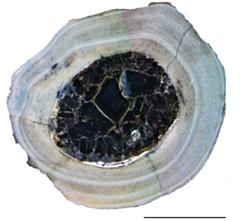Project 3673: G. A. Souza, M. B. Soares, A. S. Brum, M. Zucolotto, J. M. Sayão, L. C. Weinschütz, A. W. Kellner. 2020. Osteohistology and growth dynamics of the Brazilian noasaurid Vespersaurus paranaensis Langer et al., 2019 (Theropoda: Abelisauroidea). PeerJ. 8:e9771.
Abstract
Although the knowledge of bone histology of non-avian theropods has advanced considerably in recent decades, data about the bone tissue patterns, growth dynamics and ontogeny of some taxa such as abelisauroids are still limited. Here we describe the bone microstructure and growth dynamics of the Brazilian noasaurine Vespersaurus paranaensis using five femora and six tibiae and quantify the annual growth marks through retrocalculation of missing ones to estimate ontogenetic ages. The femoral series comprises four femoral histological classes (FHC I-IV), varying from two annuli or LAGs to seven LAGs. Femora show that sexual maturity was achieved around the seventh to tenth year of life, whereas the tibiae suggest it was earlier (around three to five years old). Tibiae represent three histological classes (THC I-III) displaying from three to nine LAGs. Two tibiae (THC III) exhibit an external fundamental system indicating that these specimens reached full skeletal size. The heterogeneous maturity observed in Vespersaurus hind limb bones could result from differential allometry scaling between femora and tibiae length with the body length. The predominant parallel-fibered bone matrix suggests that Vespersaurus grew more slowly than most theropods, including other abelisauroids, in a pattern shared with the noasaurines Masiakasaurus knopfleri from Madagascar and CPPLIP 1490 from Brazil. This deviation from the typical theropod growth pattern may be mainly correlated with small body size, but also may related to resource limitation imposed by the arid climate prevailing in southwestern Gondwana during Cretaceous. Moreover, given the ecological and phylogenetic similarities among these taxa, such features would probably be apomorphic within Noasauridae.Read the article »
Article DOI: 10.7717/peerj.9771
Project DOI: 10.7934/P3673, http://dx.doi.org/10.7934/P3673
| This project contains |
|---|
Download Project SDD File |
Currently Viewing:
MorphoBank Project 3673
MorphoBank Project 3673
- Creation Date:
25 March 2020 - Publication Date:
25 August 2020 - Media downloads: 7

Authors' Institutions ![]()
- Universidade Federal do Rio De Janeiro (UFRJ)
- Universidade Federal de Pernambuco
- Universidade do Contestado
Members
| member name | taxa |
specimens |
media | media notes |
| Geovane Souza Project Administrator | 1 | 13 | 16 | 16 |
| Marina Soares | 0 | 0 | 0 | 0 |
Project has no matrices defined.
Project downloads 
| type | number of downloads | Individual items downloaded (where applicable) |
| Total downloads from project | 149 | |
| Project downloads | 142 | |
| Media downloads | 7 | M687028 (2 downloads); M687042 (3 downloads); M687030 (1 download); M687334 (1 download); |

